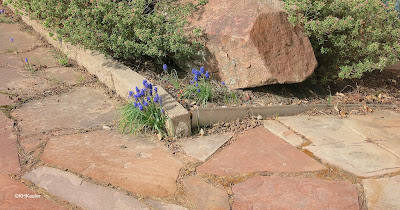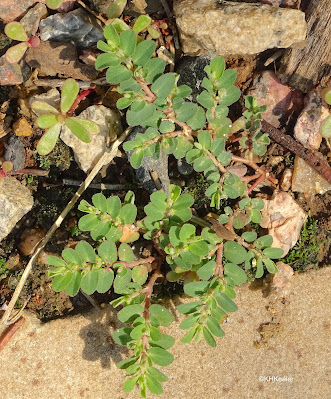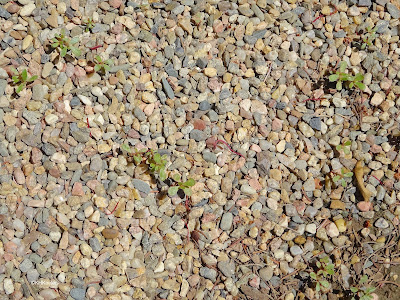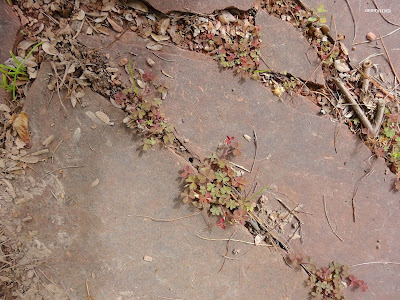I taught ecology for years. The text books feature dramatic examples of ecological principles--camouflage illustrated with a big green katydids shaped like a leaf, mimicry illustrated by a nonvenomous snake banded like a coral snake, or an example of mutualism with an orchid and exotic bee--almost always tropical. Which tended to make you think that to see biology you should go to the tropics. In fact, though, those basic principles--camouflage, mimicry, mutualism--and all the other pillars of ecology--predation, parasitism, competition--are everywhere.
 |
| camouflaged 3" preying mantis in Costa Rica |
I can list examples from prairies and North America forests. So perhaps "we just don't go out into wild places ("nature") much any more."
But, I found camouflage in my yard! Which shouldn't be such a surprise. Cities and suburbs are "nature" with wild organisms and ecological interactions. We walk by without looking, never thinking about the ongoing evolution of all those organisms to their current environment.
I have a flagstone path with reddish stone. The base was covered in reddish crushed rock (Breeze) to hold the flagstones, so the whole is a nice rusty shade. I pull plants out of the spaces between the stones in the path. The path circles my house, but I use the north side more than the south. Consequently, I glance south and, when I see weeds, get a basket and clean up the path.
 |
| red flagstone path |
A month ago, basket in hand, I discovered that a wood sorrel (probably Oxalis stricta, yellow wood sorrel, an international weed, wood sorrel family Oxalidaceae) was growing in the cracks, and was about 2" high. BUT it had red-brown leaves and was very much less visible than the dandelion leaves that drew my attention. It was the third or so time that I went after dandelions to discover an abundance of wood sorrel. That it wasn't chance; the wood sorrel was camouflaged against the path.
 |
| wood sorrel, Oxalis, probably yellow wood sorrel, Oxalis stricta |
 |
| See how much more visible the green leaves are? |
Consequently I went looking for other cases, in which leaves were camouflaged in my own back yard.
On my "to consider" list are the sandmats. These little spurges (genus Chamaesyce, spurge family Euphorbiaceae) have red stems and green leaves, and the inconspicuous flowers and fruit sit on the midline, breaking up the shape. However they do it, I find there are more of them than I think, when I stop to pull out one. Here is how it looks close up:
 |
| sandmat, Chamaesyce, probably thymeleaf sandmat, Chamaesyce serpyllifolia |
Smalls stones, called pea gravel, are a great surface for plants in Colorado, because, among other things, they retard evaporation. Look for the purslane (Portulaca oleracea, purslane family, Portulcaceae), the round leaves, in the photo below. I think they are camouflaged by the pebbles. Not as great as wood sorrel on the path, but they got pretty big before I went "wow! look at all those purslanes taking water from my desert four o'clocks!"
 |
| purslane on gravel |
I suppose I could test my hypothesis by treating weeds in two parts of the walk differently, but I lack the consistency to carry that through the next several years. So this will remain an untested hypothesis. But look around in your everyday activities; there's camouflage there. Of course, camouflage is hrd to spot. Good luck.
Comments and corrections welcome.
Post script: a very quick list of examples of important ecological interations in the garden: mimicry: bee flies can't sting you but they look at a glance like bees; mutualism: flowers shaped to accommodate some pollinating insects but not all--flat for bees and flies, tubular for hummingbirds and moths etc.; competition is the reason for weeding, because plants compete for resources; predation is finding a slug eating my lovely tomato; parasitism is represented by the worm in the juicy apple...
 |
| hovering hawkmoth on tubular flowers This one was seen in Washington, D.C., but they visit catmint (Nepeta x fassenii) in my yard |
Kathy Keeler, A Wandering Botanist
More at awanderingbotanist.com
Join me on Facebook: https://www.facebook.com/AWanderingBotanist


https://www.sciencenews.org/article/plant-camouflage-people-china-traditional-medicine-fritillaria
ReplyDeletehttps://www.nationalgeographic.com/environment/article/this-in-demand-plant-is-evolving-to-hide-from-human-predators
ReplyDeleteThanks so much for the links! I knew there were heavily- collected Asian plants, but not that the plants were adapting with camouflage. Wow!
Delete